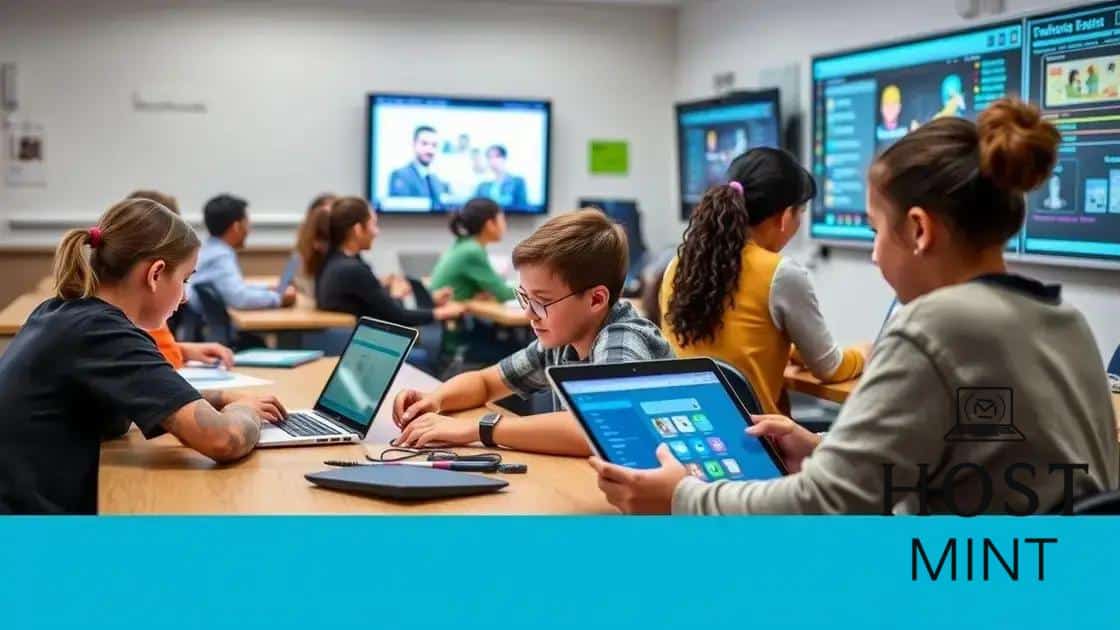How schools are addressing the homework gap effectively

Schools are addressing the homework gap by leveraging technology, fostering community partnerships, and providing resources to ensure all students have the support they need to succeed academically.
How schools are addressing the homework gap is more important than ever, especially as many students struggle with access to resources. Have you ever wondered how these gaps affect learning outcomes? Let’s dive into the strategies schools are using to tackle this issue.
Understanding the homework gap
The homework gap is a significant issue affecting students today. It refers to the disparity between students who have access to the necessary resources to complete homework and those who do not. This gap can lead to lower academic performance and hinder future opportunities for many learners.
In understanding the homework gap, it’s essential to recognize the various factors at play. Some students may lack reliable internet access, while others may not have the necessary devices. This unequal access can create a divide in learning experiences.
Key Factors Contributing to the Homework Gap
Several elements contribute to this phenomenon:
- Lack of high-speed internet in certain areas.
- Insufficient access to laptops or tablets at home.
- Variability in parental support and involvement.
- Socioeconomic challenges that prevent resource accessibility.
Understanding these factors is the first step towards tackling the homework gap. Schools and communities must join forces to address these barriers. For example, schools can offer devices and establish after-school programs that provide internet access. By creating safe spaces for students to complete their assignments, we can help level the playing field.
Moreover, awareness and dialogue are vital. When educators and families engage in conversations about the homework gap, they can work together to develop solutions that meet the needs of all students. Programs that involve community partnerships can also prove beneficial. They can provide students with the resources they need to succeed academically.
By exploring these aspects, we gain insight into the importance of bridging the homework gap. As we move forward, it’s crucial to keep these discussions alive, enabling all students to reach their full potential.
Factors contributing to the homework gap
Several key factors contribute to the homework gap, affecting many students across different backgrounds. Understanding these factors helps in addressing the challenges that hinder student success.
One major factor is the lack of access to reliable internet. Many students come from homes where high-speed internet is not available. This can prevent them from accessing online resources necessary to complete assignments.
Key Influences on the Homework Gap
Several elements play a role in creating or exacerbating the homework gap:
- Device Availability: Not all students have access to laptops or tablets at home, limiting their ability to complete homework.
- Parental Support: Some families may lack the knowledge or resources to assist children with homework, creating further barriers.
- Socioeconomic Status: Low-income families often face numerous challenges that affect students’ academic performance.
- Geographic Location: Students in rural or underserved urban areas might experience additional difficulties accessing educational facilities.
These influences can significantly impact a student’s ability to keep up with their peers. When children don’t have the resources they need, it creates gaps in learning and understanding.
In many cases, the homework gap is not just about technology; it’s also about the support systems available. Schools need to recognize these disparities to provide appropriate resources and support.
By acknowledging the factors that contribute to the homework gap, educators and policymakers can work towards developing strategies that bridge this divide, ensuring that every student has an equal opportunity to succeed.
Innovative solutions schools are implementing
Schools are increasingly recognizing the importance of tackling the homework gap and are implementing innovative solutions to bridge this divide. These strategies aim to ensure that all students have access to the resources they need for academic success.
One solution is the provision of technology resources. Many schools have started lending out devices such as laptops and tablets to students who lack access at home. By providing these tools, schools are enabling students to complete their homework and engage with digital learning platforms.
Creative Approaches to Bridging the Gap
In addition to providing technology, schools are also creating programs that give students the support they need:
- After-school programs: These programs offer students a safe space with internet access where they can do homework and receive tutoring.
- Mobile hotspots: Schools are distributing mobile hotspots to families in need, allowing them to connect to the internet at home.
- Community partnerships: Schools are collaborating with local organizations to provide resources and mentorship for students who struggle with homework.
- Homework help centers: Some schools have set up dedicated homework help centers staffed with tutors to assist students outside regular school hours.
Another innovative strategy is the integration of community resources. Schools are reaching out to local libraries and community centers, fostering partnerships that extend support outside the classroom. By leveraging these resources, students gain more access to educational materials and guidance.
Moreover, schools are focusing on training teachers to identify students who may need additional resources. Enhanced communication with families about available support can also make a significant difference. When teachers are equipped to understand their students’ challenges, they can direct them toward appropriate resources and assistance.
Utilizing these innovative solutions helps reduce the homework gap and promotes educational equity. As schools continue to adapt and evolve, they are playing a crucial role in ensuring that all students have the opportunity to succeed in their academic journey.
Role of technology in bridging the gap

The role of technology in bridging the homework gap cannot be overstated. As education continues to evolve, technology has become a vital tool in ensuring that all students have equal access to learning resources.
One way technology helps is by providing students with the tools they need to complete their homework effectively. Schools are now utilizing programs that allow students to borrow devices like laptops and tablets. With these devices, students can access online educational resources, research information, and collaborate with peers.
Essential Technological Tools
Several innovative technologies are being used to support students:
- Learning Management Systems (LMS): These platforms allow teachers to assign homework, track progress, and communicate with students, all in one place.
- Online Tutoring Services: Students can connect with tutors online, receiving help outside of school hours, which maximizes their learning opportunities.
- Educational Apps: Mobile apps provide interactive learning experiences, making homework more engaging and accessible.
- Digital Libraries: Access to online books and resources enables students to research topics in depth without needing to visit a physical library.
Technology can also facilitate communication between teachers and families. When schools utilize technology platforms to keep families informed, they create a community of support around students. Regular updates about homework assignments and available resources help parents stay involved in their children’s education.
Furthermore, the use of technology can reduce the barriers faced by students who may lack access to traditional resources. For example, by offering mobile hotspots or free internet access in community centers, schools can ensure that students have reliable connections to complete their assignments. This step is crucial in creating an equitable learning environment.
The integration of technology in education not only enhances learning but also prepares students for a tech-driven world. By bridging the homework gap through innovative technological solutions, schools are setting up all students for success, regardless of their circumstances. In an increasingly digital world, these resources are becoming essential to equitable education.
Community partnerships to support students
Community partnerships play a significant role in supporting students and addressing the homework gap. These collaborations involve schools, local businesses, and organizations working together to provide resources and mentorship to students.
One effective way these partnerships help is by providing tutoring services. Many local organizations offer after-school programs that connect students with tutors. These tutors can help students understand their homework and reinforce learning.
How Partnerships Benefit Students
Here are some ways community partnerships support students:
- Access to Resources: Many businesses donate supplies such as books, computers, and educational materials to schools, ensuring students have what they need.
- Mentorship: Community members volunteer to mentor students, providing guidance and encouragement, which can boost their confidence and academic performance.
- Programs and Workshops: Partnerships can create programs that teach students valuable skills, including study techniques and time management.
- Scholarship Opportunities: Some organizations offer scholarships or funding for extracurricular activities, helping students participate in enriching experiences.
Moreover, these partnerships can create a sense of belonging for students. When they see their community invested in their success, it fosters a positive attitude towards education. This support encourages students to take an active role in their learning.
Involving families in the community programs is also essential. When parents participate in school events and engage with local organizations, they become more aware of the resources available for their children. This awareness further helps bridge the homework gap by ensuring families are informed about the support systems in place.
Collaboration between schools and the community is crucial in addressing the challenges students face. By creating a comprehensive support system involving educators, families, and local entities, we can significantly enhance educational outcomes for all students.
FAQ – Frequently Asked Questions about Bridging the Homework Gap
What is the homework gap?
The homework gap refers to the disparity between students who have reliable access to resources like the internet and technology and those who do not.
How can technology help bridge the homework gap?
Technology provides students with access to online resources, tutoring, and communication tools, which are essential for completing homework effectively.
What role do community partnerships play in supporting students?
Community partnerships help provide additional resources, mentorship, and programs that enhance learning opportunities for students.
How can families help in addressing the homework gap?
Families can engage with schools, participate in community programs, and ensure that their children utilize available resources effectively.






